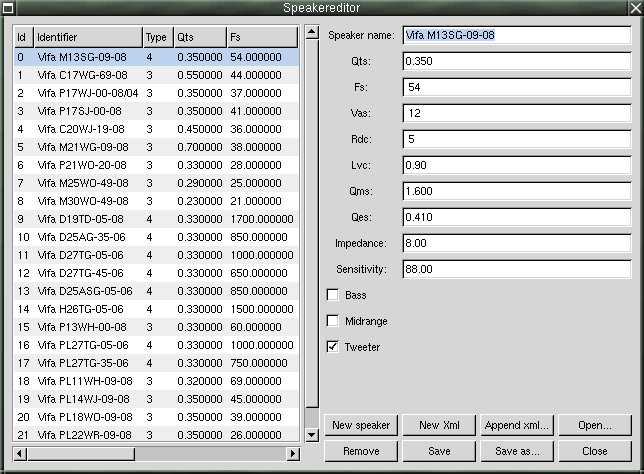GSpeakers documentation
The SpeakerEditor
The speaker editor is a utility that you can use to handle lists
of speakers.

The speaker editor window
Howto use the speakereditor
You can select speakers in the list to the left and then change parameters in the entries to the right. The data
in the list will update itself while you're changing the text in the entries.
What should I type in the entries?
Speaker name: This is a string where you can type whatever you want but preferrebly something that
identifies the speaker you want to add.
Qts: This is the total Q of the speaker. You can find this parameter in all datasheet and most mail
order catalouges. You can also search google for your speaker and you will definately find this value.
Fs: This is the resonanse frequenyc of the speaker. You can find this parameter in all datasheet and most mail
order catalouges. You can also search google for your speaker and you will definately find this value.
Vas: This is the equivalent volume for the speaker. You can find this parameter in all datasheet and most mail
order catalouges. You can also search google for your speaker and you will definately find this value.
Rdc, lvc, qms and qes: You can find these parameters in the datasheet. Rdc = voice coil resistance, Lvc = voice
coil inductance, Qms = mechanical Q, Qes = electrical Q. If you don't want to calculate more advanced filters you can
leave the default values.
Imp: Impedance of the speaker at cutoff frequency. Set it to the nominal impedance or Rdc if not sure. However, if you
have access to the datasheet for the speaker you can find an impedance curve there. There you can find out the impedance
at the intended cutoff frequency. If you work with a impedance compensation network the impedance at the cutoff
frequency will become almost the same as the resistor you use in the impedance compensation network. Also, if you are
building a crossover with cutoff <300 Hz you probably want to be very careful with this parameter.
Sens: This is the equivalent volume for the speaker. You can find this parameter in all datasheet and most mail
order catalouges. You can also search google for your speaker and you will definately find this value. You may not need
this value but it can help you to calculate damping networks if you use loudspeakers with different sensitivities
Bass, midrange, tweeter: Check checkboxes that are appropriate for the current speaker. For example, there are broadband
loudspeakers that may be bass and midrange as well as tweeter. However, those will not be very intresting to work with in
GSpeakers. Coaxial loudpspeakers (bass speakers with tweeters mounted in the center of the cone) should be separated in
the speakerlist so that the bass/midrange is one speaker and the tweeter is another so that you can use them in an appropriate
way in the crossover section of the program.
The buttons
New speaker: Click this button to add a new speaker to the bottom of the list.
New xml: Click here to create a new speakerlist/xml file.
Append xml: Appends a speakerlist to the end of the current speakerlist.
Open: Open a new speakerlist/xml file.
Remove: Remove the crrently selected speaker.
Save: Save the current speakerlist.
Save as: Save the current speakerlist to a new filename.
Daniel Sundberg, dss at home dot se
Index
